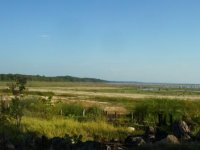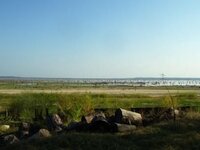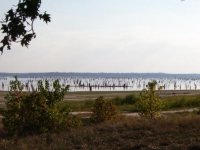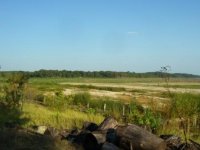Gypsy Heart
Gold Member
TOLEDO BEND RESERVOIR "" The expanding shoreline of the drought-stricken Toledo Bend Reservoir is raising more than just the ire of recreational users frustrated with the limited access and hazardous conditions.
It's also elevating the concerns of state archaeologists who have learned the exposed lake bottom has become a drawing card for curiosity seekers in search of archeological treasures hidden underneath the water's surface for the past 40 years.
Many people don't realize it is illegal to excavate or remove items from state-owned lands, including exposed riverbeds and lakebeds, said Jeff Girard, regional archaeologist on staff at Northwestern State University in Natchitoches. "It tends to get worse when there is easy public access such as what you find now on Toledo Bend. But we're trying to educate the public as much as we can," Girard said.
His main worry is the potential of losing a significant part of this region's history. Readily discovered in the past two weeks near Converse Bay is a cluster of sites providing evidence of the Caddo Nation Indian tribes living on what once was high bluffs along the Sabine River. It's not a surprise, given that the Caddo are an integral part of the state's history.
But little is known about the Caddo Nation in relation to the Sabine River basin, especially in more prehistoric times, which makes Girard's archaeological finds "" and those that might be in the hands of unsuspecting looters "" all the more important.
"A lot of the early history on the Sabine River has not been documented," Girard said.
Part of the reason can be blamed on the creation of Toledo Bend Reservoir. An idea borne out of a 1958 feasibility study, the 186,000-acre lake "" the fifth largest in the nation "" was once 150,000 acres of standing timber straddling the meandering Sabine River. Land acquisition began in 1963, with construction of the earthen dam, spillway and power plant following in 1964. Impoundment of water began in 1966.
During the construction phase, at least one Caddo Indian burial site was discovered and hundreds of remains were exhumed. "It was a site dated to the 16th century," Girard said.
The burial ground unknowingly was located behind Earline and Robert Bison's home, south of Converse, that once sat close to the Sabine River. The Bisons moved to higher ground before the lake swallowed up their family home, and Earline Bison recalls watching the University of Texas and Southern Methodist University college students painstakingly remove the Native Americans' remains.
"My husband had dug up pottery during the years when he was gardening, but we had no idea that was behind our home," Earline Bison said.
Girard is concerned that former burial site might be exposed again as Toledo Bend continues to drop to levels not witnessed since its creation. Friday, the lake measured 161.97 feet. Until earlier this month, the reservoir had never dropped below 162.5 feet. The bottom of the power pool is 162.2 feet and the top is 172 feet.
The opportunity to collect and record artifacts from Toledo Bend's lakebed is only temporary, said Phillip G. Rivet, archaeologist with the Louisiana Department of Culture, Recreation and Tourism's Division of Archaeology. "The lake will be coming back so now is a great opportunity to collect representative samples, get them cleaned and recorded."
Toledo Bend is usually at its lowest in late summer and early fall, and there's been some years that shallower parts of the lakebed, especially from the Converse area north, has been briefly void of water. But not to the extent witnessed in recent days, Sabine River Authority Executive Director Jim Pratt said.
The water has receded so much on the north end that an old roadbed extending from near the public boat launch in Converse has re-emerged. The barren roots of hundreds of tree stumps once hidden under several feet of water stick up from the now dusty ground.
Small mounds of dirt dotting the sandy soil also are evidence of the weekend artifact hunters, Girard said. Within seconds of scouting the surface, Girard picks up more than dozen small brown objects that at first glance appear to be merely pieces of chipped rock or slivers of hardened dirt.
But upon closer inspection, Girard identifies some as small pieces of clay pottery and others as crude tools that likely were used to tip a spear or used like a screwdriver.
Mark Moore found one such tool Tuesday morning. Moore, who drove to Converse Bay from his home near Marshall, Texas, walked the lakebed for only 30 minutes before finding a brown sharp-tipped stone that Girard dated anywhere from 400-500 B.C. to 500-600 A.D.
"What fascinates me is that I could be the first person to see this since then," Moore said.
Girard estimates some of the scraping tools to be 7,000 to 8,000 years old, with the pottery pieces dating to the late 1500s.
"That tells you how ancient this river area is," Pratt said.
The mixture of old and new is intriguing to Girard, who is spending several days a week walking the dusty lakebed with a GPS device in hand. Girard is able to pinpoint exact locations of the suspected cluster of Indian villages onto topographical maps to forever document this new discovery in the Caddo Nation's history.
Ancestors of the Caddo Indians were agriculturalists whose way of life emerged by 900 A.D., as revealed in archaeological sites in Arkansas, Louisiana, Texas and Oklahoma. When members of Hernando de Soto's expedition entered the region in 1542, thriving Caddo communities were distributed along several rivers, including the Sabine and Red, according to a brief history of the Caddo Nation appearing on its official Web site. Efforts to reach spokesmen Bobby Gonzales and Robert Cast were not successful Thursday or Friday.
"We don't know a lot about this river. It never was studied much. "» I don't know why. But we're trying to document as much as we can," Girard said.
That's why he cautions the weekend artifact hunters to not remove or unearth objects. "The early history of this area is being lost. And from the Caddo's point of view, this is their history. How would you like it if someone came digging around in your grandparents back yard?"
While it against the law for people to remove items from the lakebed, Pratt admits it is almost impossible for the SRA to enforce it. Pratt asks citizens to contact Girard if they find or have found anything significant.
"We want people to know we won't confiscate their finds. We just want to document them because once it's lost, it's lost," Girard said.
Rivet said another concern is the possible disturbance of human remains should the collectors move beyond scraping the surface.
"Our main issue is to make the public aware that it is illegal to dig for artifacts," Rivet said.
http://www.archaeologynews.org/Link...ceding reservoir exposes archaeological sites
It's also elevating the concerns of state archaeologists who have learned the exposed lake bottom has become a drawing card for curiosity seekers in search of archeological treasures hidden underneath the water's surface for the past 40 years.
Many people don't realize it is illegal to excavate or remove items from state-owned lands, including exposed riverbeds and lakebeds, said Jeff Girard, regional archaeologist on staff at Northwestern State University in Natchitoches. "It tends to get worse when there is easy public access such as what you find now on Toledo Bend. But we're trying to educate the public as much as we can," Girard said.
His main worry is the potential of losing a significant part of this region's history. Readily discovered in the past two weeks near Converse Bay is a cluster of sites providing evidence of the Caddo Nation Indian tribes living on what once was high bluffs along the Sabine River. It's not a surprise, given that the Caddo are an integral part of the state's history.
But little is known about the Caddo Nation in relation to the Sabine River basin, especially in more prehistoric times, which makes Girard's archaeological finds "" and those that might be in the hands of unsuspecting looters "" all the more important.
"A lot of the early history on the Sabine River has not been documented," Girard said.
Part of the reason can be blamed on the creation of Toledo Bend Reservoir. An idea borne out of a 1958 feasibility study, the 186,000-acre lake "" the fifth largest in the nation "" was once 150,000 acres of standing timber straddling the meandering Sabine River. Land acquisition began in 1963, with construction of the earthen dam, spillway and power plant following in 1964. Impoundment of water began in 1966.
During the construction phase, at least one Caddo Indian burial site was discovered and hundreds of remains were exhumed. "It was a site dated to the 16th century," Girard said.
The burial ground unknowingly was located behind Earline and Robert Bison's home, south of Converse, that once sat close to the Sabine River. The Bisons moved to higher ground before the lake swallowed up their family home, and Earline Bison recalls watching the University of Texas and Southern Methodist University college students painstakingly remove the Native Americans' remains.
"My husband had dug up pottery during the years when he was gardening, but we had no idea that was behind our home," Earline Bison said.
Girard is concerned that former burial site might be exposed again as Toledo Bend continues to drop to levels not witnessed since its creation. Friday, the lake measured 161.97 feet. Until earlier this month, the reservoir had never dropped below 162.5 feet. The bottom of the power pool is 162.2 feet and the top is 172 feet.
The opportunity to collect and record artifacts from Toledo Bend's lakebed is only temporary, said Phillip G. Rivet, archaeologist with the Louisiana Department of Culture, Recreation and Tourism's Division of Archaeology. "The lake will be coming back so now is a great opportunity to collect representative samples, get them cleaned and recorded."
Toledo Bend is usually at its lowest in late summer and early fall, and there's been some years that shallower parts of the lakebed, especially from the Converse area north, has been briefly void of water. But not to the extent witnessed in recent days, Sabine River Authority Executive Director Jim Pratt said.
The water has receded so much on the north end that an old roadbed extending from near the public boat launch in Converse has re-emerged. The barren roots of hundreds of tree stumps once hidden under several feet of water stick up from the now dusty ground.
Small mounds of dirt dotting the sandy soil also are evidence of the weekend artifact hunters, Girard said. Within seconds of scouting the surface, Girard picks up more than dozen small brown objects that at first glance appear to be merely pieces of chipped rock or slivers of hardened dirt.
But upon closer inspection, Girard identifies some as small pieces of clay pottery and others as crude tools that likely were used to tip a spear or used like a screwdriver.
Mark Moore found one such tool Tuesday morning. Moore, who drove to Converse Bay from his home near Marshall, Texas, walked the lakebed for only 30 minutes before finding a brown sharp-tipped stone that Girard dated anywhere from 400-500 B.C. to 500-600 A.D.
"What fascinates me is that I could be the first person to see this since then," Moore said.
Girard estimates some of the scraping tools to be 7,000 to 8,000 years old, with the pottery pieces dating to the late 1500s.
"That tells you how ancient this river area is," Pratt said.
The mixture of old and new is intriguing to Girard, who is spending several days a week walking the dusty lakebed with a GPS device in hand. Girard is able to pinpoint exact locations of the suspected cluster of Indian villages onto topographical maps to forever document this new discovery in the Caddo Nation's history.
Ancestors of the Caddo Indians were agriculturalists whose way of life emerged by 900 A.D., as revealed in archaeological sites in Arkansas, Louisiana, Texas and Oklahoma. When members of Hernando de Soto's expedition entered the region in 1542, thriving Caddo communities were distributed along several rivers, including the Sabine and Red, according to a brief history of the Caddo Nation appearing on its official Web site. Efforts to reach spokesmen Bobby Gonzales and Robert Cast were not successful Thursday or Friday.
"We don't know a lot about this river. It never was studied much. "» I don't know why. But we're trying to document as much as we can," Girard said.
That's why he cautions the weekend artifact hunters to not remove or unearth objects. "The early history of this area is being lost. And from the Caddo's point of view, this is their history. How would you like it if someone came digging around in your grandparents back yard?"
While it against the law for people to remove items from the lakebed, Pratt admits it is almost impossible for the SRA to enforce it. Pratt asks citizens to contact Girard if they find or have found anything significant.
"We want people to know we won't confiscate their finds. We just want to document them because once it's lost, it's lost," Girard said.
Rivet said another concern is the possible disturbance of human remains should the collectors move beyond scraping the surface.
"Our main issue is to make the public aware that it is illegal to dig for artifacts," Rivet said.
http://www.archaeologynews.org/Link...ceding reservoir exposes archaeological sites
Upvote
0













